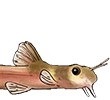Zanata, AM & C Primitivo, 2014. Natural history of Copionodon pecten, an endemic trichomycterid catfish from Chapada Diamantina in northeastern Brazil. Journal of Natural History 48: 203–228.
Abstract
The natural history of Copionodon pecten was studied based on observations of individuals inhabiting the Coisa Boa River in the Paraguaçu Basin, Chapada Diamantina, Bahia State, Brazil. This catfish is mainly benthonic and dwells in pools beneath riffles, over rocky substrates. Periods of activity, spatial distribution, foraging strategy and diet show variation according to ontogenetic stage, together with variation in external morphological characteristics. Small juveniles are diurnally active, swim mainly in the water column near the border of shallow pools and feed mainly on algae (Spirogyra sp.). Sub-adults and adults of C. pecten are strongly active at night, occupy the bottom of shallow pools and feed mainly on a complex of periphytic algae scratched from the substrate. Dissected specimens have a long digestive tract, which is in accordance with a predominantly algivorous diet. Immature aquatic insects constitute an important food item throughout the life of the fish. Small individuals are gregarious at night, whereas adults congregate especially during the day. When less active, these catfish are observed usually in polarized groups facing upstream. Adult individuals are apparently more numerous than juveniles within the studied population. No distinct reproductive season was recorded for C. pecten during the study, with mature individuals present throughout the year. Oocytes in various stages of development were observed within ovaries, suggesting multiple spawning over a long reproductive period. The species has low fecundity and does not show parental care or external sexual dimorphism. No evidence for a complex behavioural repertoire was found and medium- to large-sized specimens have a tendency to occupy deeper and more sheltered places.
Natural history of Copionodon pecten
- Silurus
- Posts: 12420
- Joined: 31 Dec 2002, 11:35
- I've donated: $12.00!
- My articles: 55
- My images: 893
- My catfish: 1
- My cats species list: 90 (i:1, k:0)
- Spotted: 424
- Location 1: Singapore
- Location 2: Moderator Emeritus
- Richard B
- Posts: 6952
- Joined: 11 Aug 2006, 13:19
- I've donated: $20.00!
- My articles: 9
- My images: 11
- My cats species list: 37 (i:0, k:0)
- My aquaria list: 4 (i:0)
- My BLogs: 2 (i:0, p:47)
- Spotted: 10
- Location 1: on the sofa, or maybe at work?
- Location 2: Warwickshire: UK
- Interests: Tanganyika Catfish, African catfish, Non-loricariid sucker-catfish.
Running, drinking, eating, sci-fi, stapelids
Re: Natural history of Copionodon pecten
Sounds very interesting & not in the Clog? Is there a pdf available on this?
Lou: Every young man's fantasy is to have a three-way.
Jacob: Yeah not with another fu**!ng guy!
Lou: It's still a three-way!
Hot Tub Time Machine: 2010
Jacob: Yeah not with another fu**!ng guy!
Lou: It's still a three-way!
Hot Tub Time Machine: 2010
- Jools
- Expert
- Posts: 16148
- Joined: 30 Dec 2002, 15:25
- My articles: 198
- My images: 948
- My catfish: 237
- My cats species list: 87 (i:237, k:1)
- My BLogs: 7 (i:10, p:202)
- My Wishlist: 23
- Spotted: 450
- Location 1: Middle Earth,
- Location 2: Scotland
- Interests: All things aquatic, Sci-Fi, photography and travel. Oh, and beer.
- Contact:
Re: Natural history of Copionodon pecten
https://repositorio.ufba.br/ri/bitstrea ... NITIVA.pdf appears to be an early version?Richard B wrote:Is there a pdf available on this?
Jools
Owner, AquaticRepublic.com, PlanetCatfish.com & ZebraPleco.com. Please consider donating towards this site's running costs.





